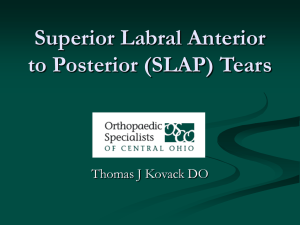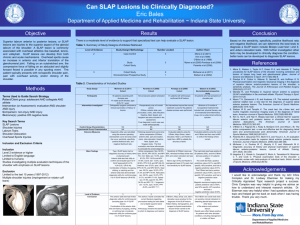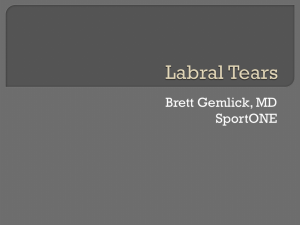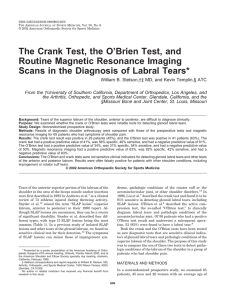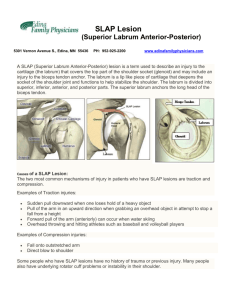Clinical Testing for Tears of the Glenoid Labrum
advertisement
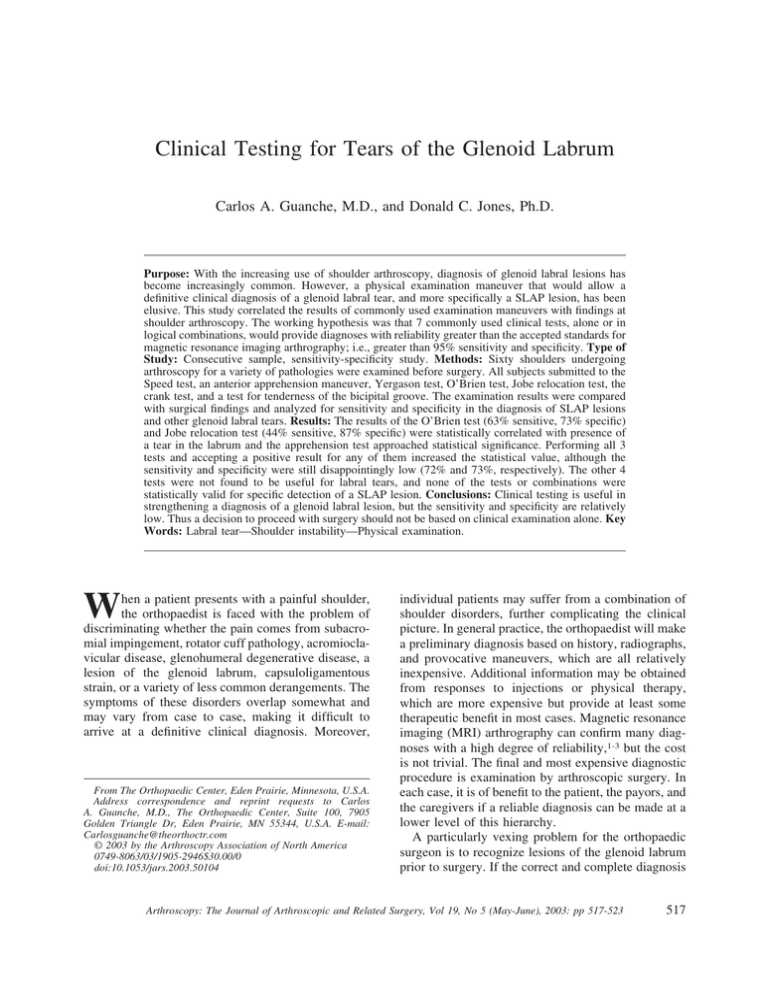
Clinical Testing for Tears of the Glenoid Labrum Carlos A. Guanche, M.D., and Donald C. Jones, Ph.D. Purpose: With the increasing use of shoulder arthroscopy, diagnosis of glenoid labral lesions has become increasingly common. However, a physical examination maneuver that would allow a definitive clinical diagnosis of a glenoid labral tear, and more specifically a SLAP lesion, has been elusive. This study correlated the results of commonly used examination maneuvers with findings at shoulder arthroscopy. The working hypothesis was that 7 commonly used clinical tests, alone or in logical combinations, would provide diagnoses with reliability greater than the accepted standards for magnetic resonance imaging arthrography; i.e., greater than 95% sensitivity and specificity. Type of Study: Consecutive sample, sensitivity-specificity study. Methods: Sixty shoulders undergoing arthroscopy for a variety of pathologies were examined before surgery. All subjects submitted to the Speed test, an anterior apprehension maneuver, Yergason test, O’Brien test, Jobe relocation test, the crank test, and a test for tenderness of the bicipital groove. The examination results were compared with surgical findings and analyzed for sensitivity and specificity in the diagnosis of SLAP lesions and other glenoid labral tears. Results: The results of the O’Brien test (63% sensitive, 73% specific) and Jobe relocation test (44% sensitive, 87% specific) were statistically correlated with presence of a tear in the labrum and the apprehension test approached statistical significance. Performing all 3 tests and accepting a positive result for any of them increased the statistical value, although the sensitivity and specificity were still disappointingly low (72% and 73%, respectively). The other 4 tests were not found to be useful for labral tears, and none of the tests or combinations were statistically valid for specific detection of a SLAP lesion. Conclusions: Clinical testing is useful in strengthening a diagnosis of a glenoid labral lesion, but the sensitivity and specificity are relatively low. Thus a decision to proceed with surgery should not be based on clinical examination alone. Key Words: Labral tear—Shoulder instability—Physical examination. W hen a patient presents with a painful shoulder, the orthopaedist is faced with the problem of discriminating whether the pain comes from subacromial impingement, rotator cuff pathology, acromioclavicular disease, glenohumeral degenerative disease, a lesion of the glenoid labrum, capsuloligamentous strain, or a variety of less common derangements. The symptoms of these disorders overlap somewhat and may vary from case to case, making it difficult to arrive at a definitive clinical diagnosis. Moreover, From The Orthopaedic Center, Eden Prairie, Minnesota, U.S.A. Address correspondence and reprint requests to Carlos A. Guanche, M.D., The Orthopaedic Center, Suite 100, 7905 Golden Triangle Dr, Eden Prairie, MN 55344, U.S.A. E-mail: Carlosguanche@theorthoctr.com © 2003 by the Arthroscopy Association of North America 0749-8063/03/1905-2946$30.00/0 doi:10.1053/jars.2003.50104 individual patients may suffer from a combination of shoulder disorders, further complicating the clinical picture. In general practice, the orthopaedist will make a preliminary diagnosis based on history, radiographs, and provocative maneuvers, which are all relatively inexpensive. Additional information may be obtained from responses to injections or physical therapy, which are more expensive but provide at least some therapeutic benefit in most cases. Magnetic resonance imaging (MRI) arthrography can confirm many diagnoses with a high degree of reliability,1-3 but the cost is not trivial. The final and most expensive diagnostic procedure is examination by arthroscopic surgery. In each case, it is of benefit to the patient, the payors, and the caregivers if a reliable diagnosis can be made at a lower level of this hierarchy. A particularly vexing problem for the orthopaedic surgeon is to recognize lesions of the glenoid labrum prior to surgery. If the correct and complete diagnosis Arthroscopy: The Journal of Arthroscopic and Related Surgery, Vol 19, No 5 (May-June), 2003: pp 517-523 517 518 C. A. GUANCHE AND D. C. JONES is not made (and it often is not), the surgeon may prepare the patient for a subacromial decompression or distal clavicle resection only to discover intraoperatively that there is a labral lesion for which the patient and surgeon are unprepared. MRI arthrography is used as a preoperative measure to avoid this type of surprise, but if there were a good clinical test for labral lesions, it might be possible to avoid the expense of MRI in some cases. Several physical examination maneuvers have been described for evaluating the integrity of all or part of the glenoid labrum. The specificity and sensitivity of these tests have been reported by some authors as being excellent,4-9 but these results may be of limited value in a general clinical population because they were restricted to a selection of patients with known or suspected labral lesions.10 There may also be a publication bias arising from the tendency to select manuscripts reporting optimistic and positive results over those that are more neutral. The current study was designed to evaluate 7 clinical tests for tears of the glenoid labrum. Of particular interest was whether these tests would be of significant diagnostic value when applied to a general population of shoulder patients with a variety of pathologic conditions. A secondary objective was to determine whether any of the same clinical tests would aid in discriminating SLAP lesions (superior labrum anterior and posterior)11 from other labral lesions, i.e., those not involving the biceps origin. SLAP lesions are notoriously difficult to recognize in the clinical presentation because there is often no history of dislocation or subluxation that might corroborate the suspicion of a labral tear.11 The working hypothesis was that 1 or more of the 7 tests, either alone or in logical combinations, would prove to be at least as reliable as arthrographic MRI, which has been reported to be more than 90% sensitive and specific.1,2 METHODS A prospective diagnostic protocol was applied to 61 consecutive patients (62 shoulders) undergoing arthroscopy of the shoulder for a variety of activity-related complaints (Table 1). Patients were included in the study only if this was their first surgery on the involved shoulder, if there was a complete physical examination immediately prior to surgery, and if a complete range of motion could be obtained while under anesthesia. Only 2 patients were excluded based on the last criterion, leaving a study population of 60 shoulders in 59 patients. TABLE 1. Preoperative Diagnoses in a Series of 60 Shoulders Preoperative Primary Diagnosis No. of Shoulders SLAP lesion Labral tear Acromioclavicular DJD Subacromial impingement 15 4 20 21 Abbreviation: DJD, degenerative joint disease. All patients had undergone nonoperative care before surgical intervention. The protocols included a series of subacromial cortisone injections (3 at most) followed by physical therapy in those with impingement. Those patients with suspected acromioclavicular joint arthritis had been injected with cortisone into the joint without lasting pain relief. Patients with presumed labral pathology also went through a course of progressive physical therapy and activity modification. Immediately before surgery, while in the holding area of the operating room and before the administration of any anesthetic or narcotic agent, each patient was examined by the principal author (C.A.G.) using a battery of 7 provocative maneuvers. These maneuvers have been reported to be sensitive and specific for lesions of the glenoid labrum: The Speed test (as described by Bennett, Fig 1),4 anterior apprehension maneuver (Fig 2),12 Yergason test (as described by Hawkins and Bokor, Fig 3),12 O’Brien test (Fig 4),9 Jobe relocation test (Fig 5),13 crank test (Fig 6),7 and tenderness of the bicipital groove.8 The tests were performed in the order listed. The O’Brien test was considered positive only if the patient specifically reported deep pain, rather than a more superficial pain characteristic of acromioclavicular joint pathology. In a subset of patients, the locus of pain was not asked, so these 27 cases were excluded from statistical analyses involving the O’Brien test. This discrepancy weakened the study somewhat, but the statistical analyses were still valid because the number of missing data points were taken into account. The “SLAPrehension” test described by Berg and Cuillo5 and the biceps load test of Kim et al.6 were not included because they were not yet published when the current study began. The authors were not familiar with the Kibler test14 so it was not included in this study. Patients underwent arthroscopic evaluation of the shoulder in the beach-chair position. In all cases, the glenohumeral joint was first evaluated and the pathol- TESTING FOR GLENOID LABRUM TEARS FIGURE 1. Speed test: Forward elevation against resistance produces pain in a positive test. ogy addressed as appropriate. Subsequently, the subacromial space was evaluated as was the acromioclavicular joint in those with clinical symptomatology localized to that joint, and appropriate treatments were performed. Finally, lesions of the glenohumeral joint were addressed. An analysis of the clinical findings and their correlation with the arthroscopic examination was then undertaken to determine the sensitivity and specificity of each of the tests with respect to the diagnosis of a FIGURE 2. Anterior apprehension test: If passive abduction and external rotation causes pain, the result is positive test. 519 FIGURE 3. Yergason test: With the elbow at 90°, the subject supinates the forearm against the examiner’s resistance. The examiner simultaneously palpates the biceps tendon (long head). Unusual pain in the biceps tendon is a positive result. glenoid labral tear. Furthermore, the 6 basic tests were analyzed in pairs using the AND and OR logical operators, to determine whether the results of 2 tests could be combined to yield more reliable results than either test alone. The question of whether superior labral tears (SLAP lesions) could be separated from other labral tears was also addressed. In this study, a SLAP lesion was defined as a disruption of the superior labrum11 between 10 and 2 o’clock of the glenoid face. Those lesions not found to have a significant disruption of the biceps anchor were classified as Type I.11 Lesions classified as labral tears were disruptions of the labrum inferior to 10- and 2-o’clock. The same seven tests and their logical combinations were analyzed for sensitivity and specificity with respect to SLAP lesions. Statistical analyses were performed with the aid of StatView software (SAS Institute, Cary, NC). The -square test was used to compare the results of each clinical test (positive or negative) with the arthroscopic diagnosis (lesion present or absent). Logical combinations of the tests were analyzed in the same way. The critical level for declaring statistical significance was set at P ⫽ .05. Estimation of the statistical power of each -square test was done using the method described by Lipsey.15 520 C. A. GUANCHE AND D. C. JONES FIGURE 4. (A) O’Brien test, part I: The patient adducts 10°, points the thumb down, and elevates against resistance. Pain in the shoulder is a positive finding. (B) O’Brien test, part II: This is the same as part I except that the thumb is up. Reduced pain in the thumb-up position relative to thumb-down is a positive result. RESULTS There were 48 men and 11 women in the study, with an average age of 38 years (range, 15 to 76 years). All but 1 patient could relate their shoulder pain to overuse or injury and all had failed conservative management for their respective problems. There were various mechanisms of the original injury, including overuse in 33 shoulders, dislocation in 17, trauma without dislocation in 6, traction injuries with an eccentric load on the involved upper extremity in 3, and an uncertain mechanism in 1 patient. The surgical findings in this heterogeneous population (Table 2) included labral lesions (53 total), capsular lesions (6), Hill-Sachs lesions (15), degenerative disease of the glenohumeral and acromioclavicular joints (33), acromial osteophytes (33), and rotator cuff FIGURE 5. Jobe relocation test: The arm is abducted and externally rotated. The examiner applies posterior pressure to the arm and then releases it. Pain on release is positive. tears (11). There were multiple findings in many cases. The only basic tests that showed statistically significant correlations (P ⬍ .05, -square test) between a labral tear (SLAP or otherwise) and a positive test were the Jobe relocation test and O’Brien test (Table 3). However, the sensitivities for those 2 tests, 44% and 63%, respectively, were low enough to suggest that they might be of limited clinical value. The specificities were somewhat better: 87% and 73%, respectively. The anterior apprehension test approached statistical significance (P ⫽ .058) and had 40% sensitivity with 87% specificity. The crank test, Speed test, Yergason test, and bicipital groove tenderness, although reported to be useful in diagnosis of labral lesions,7,8 proved to be unreliable in our hands (Table FIGURE 6. Crank test: The examiner moves the shoulder into full abduction and then rotates internally and externally while axially loading the glenohumeral joint. Pain and/or a click are positive. TESTING FOR GLENOID LABRUM TEARS TABLE 2. Surgical Findings in a Series of 60 Shoulders Surgical Finding No. of Shoulders SLAP lesion Type I* Type II* Type III* Type IV* Labral tear Anterior Posterior Inferior Glenohumeral DJD Hill-Sachs lesion Capsular strain or sprain Rotator cuff tear Partial Full-thickness Acromioclavicular DJD Acromial osteophytes 11 19 1 2 15 4 1 7 15 6 8 3 26 33 NOTE. Some shoulders had more than one of these findings. *Terminology of Snyder et al.11 3). None of the 7 tests provided statistically significant results for specifically identifying SLAP lesions (Table 3). Because the Jobe relocation, O’Brien, and anterior apprehension tests appeared to be of some value for diagnosing glenoid labral lesions, it was thought that some combinations of those tests might be of greater value than any of them separately. Table 4 shows that requiring 2 or more of the 3 tests to be positive (logical AND) tends to decrease sensitivity and in- 521 crease specificity over the individual tests. Requiring all 3 tests to be positive reduces sensitivity further, without any gain in specificity (Table 4). On the other hand, allowing any of the 3 tests to be positive (logical OR) results in relatively high sensitivity (72%) and specificity (73%) with a high statistical reliability (P ⫽ .009) for diagnosing labral lesions, including SLAP lesions (Table 4). However, no logical combinations of the Jobe relocation, O’Brien, anterior apprehension, or crank tests were found to be of value for diagnosing a SLAP lesion as a separate entity. The proportion of subjects with labral lesions (SLAP, tear, and/or Bankart) was 75% (45 of 60 patients). If it is assumed that our group of patients with shoulder pain is typical, then if a positive predictive value of 88% and a negative of 47% (from Table 4) are applied, it can be calculated that 78% of the cases would have true positive or true negative tests. Thus, 22% would be misdiagnosed. The statistical power of this study was estimated as being about 0.84, based on the following rationale: The critical level of significance had been set at P ⫽ .05, so the power of the conclusions arrived at in this study would be the apparent power at this boundary. Apparent power was calculated post hoc for each of the 7 clinical maneuvers using the actual number of subjects (43 for the O’Brien test and 60 for the others), the predetermined threshold for significance (P ⫽ .05), and the apparent effect size (the observed difference between the clinical diagnosis and the arthroscopic diagnosis). The lowest apparent power among TABLE 3. Utility of Several Examination Maneuvers for Diagnosis of Tears in the Glenoid Labrum Maneuver Any labral lesion, including SLAP Jobe relocation test O’Brien test Anterior apprehension test Bicipital groove tenderness Crank test Speed test Yergason test SLAP lesions only Jobe relocation test O’Brien test Anterior apprehension test Bicipital groove tenderness Crank test Speed test Yergason test *Statistically significant. Sensitivity Specificity Positive Predictive Value Negative Predictive Value P (-square) 44% 63% 40% 44% 40% 18% 9% 87% 73% 87% 40% 73% 87% 93% 91% 87% 90% 69% 82% 80% 80% 34% 40% 33% 19% 29% 26% 25% .030* .043* .058 .296 .353 .689 .787 36% 54% 30% 48% 39% 9% 12% 63% 47% 63% 52% 67% 74% 96% 55% 57% 50% 55% 59% 30% 80% 45% 45% 43% 45% 47% 40% 47% .957 .920 .582 .979 .628 .082 .240 522 C. A. GUANCHE AND D. C. JONES TABLE 4. Reliability of Logical Combinations of Jobe Relocation, O’Brien, and Anterior Apprehension Tests for Tears of the Glenoid Labrum Logical Combination Sensitivity Specificity Positive Predictive Value Negative Predictive Value P (-square) Jobe AND O’Brien Jobe AND apprehension O’Brien AND apprehension Jobe AND O’Brien AND apprehension 41% 38% 38% 34% 91% 93% 82% 91% 93% 94% 86% 92% 34% 33% 31% 32% .054 .023* .238 .107 Jobe OR O’Brien Jobe OR apprehension O’Brien OR apprehension Jobe OR O’Brien OR apprehension 72% 47% 72% 72% 73% 80% 73% 73% 88% 88% 88% 88% 47% 33% 47% 47% .009* .068 .009* .009* NOTE. Logical AND means that the 2 tests must both be positive to score a positive result. Logical OR means that if either of the 2 tests are positive, or both are positive, then the logical result is positive. *Statistically significant. statistically significant findings (i.e., among the findings with P ⬍ .05) was 0.82. The highest apparent power among the statistically insignificant findings (P ⬎ .05) was 0.86. Thus, the actual power could be estimated as the average of these 2 numbers, which bracket the decision level for statistical significance. DISCUSSION Diagnosis of labral lesions before surgery, with or without MRI, is important for 3 reasons: First, specific patient consent is necessary for the operative repair of a labral lesion. That is, the surgeon cannot repair a labral lesion based on consent for a simple arthroscopic debridement or acromioplasty because the postoperative regime and the associated limitations are significantly different. Second, the availability of specialized equipment for arthroscopic repair of a torn labrum may be an issue. If the required equipment is not readily available when the lesion is discovered at arthroscopy, it may be necessary to schedule a second surgery to provide effective treatment. And third, some surgeons may not be skilled in the arthroscopic techniques that are necessary to repair unexpected labral lesions. In the best circumstances, the surgeon may call on a more skilled colleague in the operating theater, but if one is not immediately available, a second surgery would be required. Thus, it is apparent that patients, payors, and providers would benefit substantially if there were a reliable clinical test for labral lesions, precluding the cost and inconvenience of MRI arthrography. Unfortunately, the present study was not able to identify any clinical test or combination of tests that would provide that level of benefit. Three clinical maneuvers, the Jobe relocation, O’Brien, and anterior apprehension tests, were all found to have at least some value (Table 3). Furthermore, using all 3 tests and accepting any positive result was found to be more powerful than relying on any single maneuver (Table 4). Yet, with sensitivities and specificities less than 75%, these clinical tests are far inferior to MRI arthrography, which has been reported to produce sensitivity and specificity of 90% or better for diagnosis of labral tears.1,2 Four other maneuvers, the crank, bicipital groove tenderness, Speed, and Yergason tests, were found to be of no significant diagnostic value whatsoever, either separately or in combination, for diagnosis of labral tears. An orthopaedic surgeon might look at Table 4 and ask, “If I use Jobe test and O’Brien test and accept a positive finding from either test, how many of my patients will be correctly diagnosed?” The answer depends on the proportion of patients presenting with a true labral tear. If all patients have a tear, then 88% (the positive predictive value) would be diagnosed correctly. If none of them have such a tear, then 47% (the negative predictive value) of the diagnoses would be correct. If the proportion is intermediate, then the 88% and 47% figures should be weighted. For example, in the population described here, the true proportion of patients with labral tears was 75%, so the likelihood of correct diagnosis (true positive or true negative) would be 75% ⫻ 88% ⫹ 25% ⫻ 47% ⫽ 78%. The results presented in Tables 3 and 4 can be compared directly with a few other published reports. O’Brien described his test as being 100% sensitive and 98.5% specific for labral lesions.9 In contrast, the current study found O’Brien’s test to be only 63% TESTING FOR GLENOID LABRUM TEARS sensitive and 73% specific for all labral lesions (including SLAP lesions). O’Brien’s results may have been biased by performing arthroscopic examinations only on patients with positive test results, thus neglecting the group that may have had an occult labral lesion. A later study by Stetson and Templin focused specifically on SLAP lesions and showed that the O’Brien test had a sensitivity of 67% and a specificity of 41%.10 This study was more in agreement with the current findings of 54% sensitivity and 47% specificity for SLAP lesions (Table 3) and the study population was similar in that all patients were examined arthroscopically. The crank test7 was reported originally to have a sensitivity of 90% and a specificity of 85% in the diagnosis of glenoid labral tears. However, the study population was a select group suspected to have labral tears. The current study, using a more heterogeneous series of patients, found the crank test to be only 40% sensitive and 73% specific for labral tears. The study by Stetson and Templin10 used the crank test specifically to diagnose SLAP lesions from a consecutive series of patients with a variety of pathologies, and found only 64% sensitivity and 67% specificity. In the current study, the crank test was even less sensitive for SLAP lesions (39%), although the specificity (67%) was the same as reported by Stetson and Templin. With regard to the Speed, Yergason, and bicipital groove pain tests, the current study provided no corroboration for the findings of Morgan et al.8 that all 3 are useful in diagnosing type II SLAP lesions. However, it should be noted that the current study did not analyze SLAP lesions by types or subtypes as did Morgan et al., so the results are not directly comparable. Furthermore, the report of Morgan et al. was based on a group of patients with known SLAP lesions, in contrast with the current series of patients which had a variety of pathologies. One weakness of this study may be the exclusion of the 27 patients whose O’Brien examination was not complete. In these patients, the locus of pain was not recorded. In the power analysis we performed, however, the statistics appear to be valid. It is theoretically possible that the sensitivity and/or specificity may be significantly different if all of these patients were negative or positive. This fact and the small numbers in our study has led to beginning a larger prospective series for further validation. 523 In summary, the ability to prospectively diagnose labral tears generally, and SLAP lesions specifically, would be highly desirable. The current standard battery of maneuvers does not appear adequate for this determination. A high degree of confidence is required to inform the patient of the diagnosis and the treatment options and to be technically prepared to deal with the encountered pathology. REFERENCES 1. Bencardino JT, Beltran J, Rosenberg ZS, et al. Superior labrum anterior-posterior lesions: Diagnosis with MR arthrography of the shoulder. Radiology 2000;214:267-271. 2. Cvitanic O, Tirman PF, Feller JF, Bost FW, Minter J, Carroll KW. Using abduction and external rotation of the shoulder to increase the sensitivity of MR arthrography in revealing tears of the anterior glenoid labrum. AJR Am J Roentgenol 1997; 169:837-844. 3. Jee W-H, McCauley TR, Katz LD, Matheny JM, Ruwe PA, Daigneault JP. Superior labral anterior posterior (SLAP) lesions of the glenoid labrum: Reliability and accuracy of MR arthrography for diagnosis. Radiology 2001;218:127-132. 4. Bennett WF. Specificity of the Speed test: Arthroscopic technique for evaluating the biceps tendon at the level of the bicipital groove. Arthroscopy 1998;14:789-796. 5. Berg EE, Ciullo JV. A clinical test for superior glenoid labral or ‘SLAP’ lesions. Clin J Sports Med 1998;8:121-123. 6. Kim S-H, Ha K-I, Ahn J-H, Kim S-H, Choi H-J. Biceps load test II: A clinical test for SLAP lesions of the shoulder. Arthroscopy 2001;17:160-164. 7. Liu SH, Henry MH, Nuccion SL. A prospective evaluation of a new physical examination in predicting glenoid labral tears. Am J Sports Med 1996;24:721-725. 8. Morgan CD, Burkhart SS, Palmeri M, Gillespie M. Type II SLAP lesions: Three subtypes and their relationships to superior instability and rotator cuff tears. Arthroscopy 1998;14: 553-565. 9. O’Brien SJ, Pagnani MJ, Fealy S, McGlynn SR, Wilson JB. The active compression test: A new and effective test for diagnosing labral tears and acromioclavicular joint abnormality. Am J Sports Med 1998;26:610-613. 10. Stetson WB, Templin KT. Sensitivity of the crank test vs. the O’Brien test in detecting SLAP lesions of the shoulder. Presented at the American Shoulder and Elbow Surgeons’ Specialty Day, Anaheim, CA, February 1999. 11. Snyder SJ, Karzel RP, Del Pizzo W, et al. SLAP lesions of the shoulder. Arthroscopy 1990;6:274-279. 12. Hawkins RJ, Bokor DJ. Clinical evaluation of shoulder problems. In: Rockwood CA, Matsen FA, eds. The shoulder. Philadelphia: WB Saunders, 1990;149-177. 13. Jobe FW, Tibone JE, Jobe CM, Kvitne RS. The shoulder in sports. In: Rockwood CA, Matsen FA, eds. The shoulder. Philadelphia: WB Saunders, 1990;961-990. 14. Kibler WB. Specificity and sensitivity of the anterior slide test in throwing athletes with superior glenoid labral tears. Arthroscopy 1995;11:296-300. 15. Lipsey MW. Design sensitivity. Statistical power for experimental research. Newbury Park, CA: Sage, 1990.
